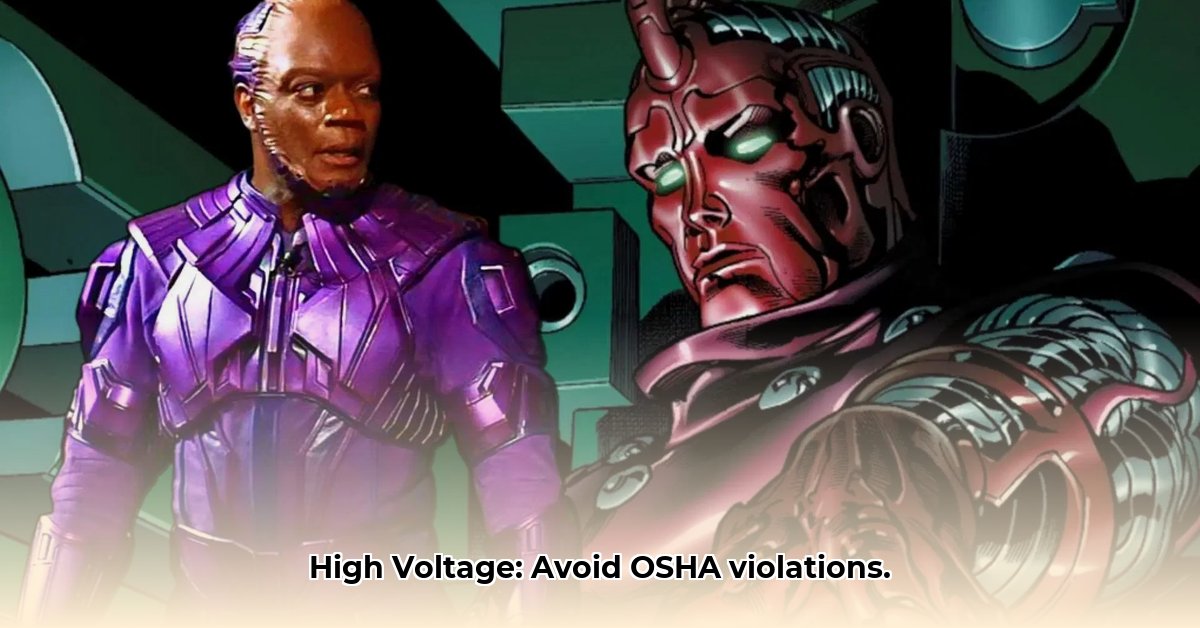High voltage electricity poses significant risks, making clear and visible warning signs crucial in any workplace. This guide provides in-depth information on selecting, installing, maintaining, and optimizing high-voltage signs for safety and OSHA compliance.
Choosing the Right Material for High Voltage Signage
Selecting the appropriate material is pivotal for the longevity and effectiveness of high-voltage signs. Understanding the properties of different materials is essential for ensuring safety and maximizing the return on investment.
Aluminum vs. Steel: A Detailed Comparison
Aluminum and steel are the two most common materials for high-voltage signs, each with unique advantages and disadvantages. The following table provides a detailed comparison:
| Material | Advantages | Disadvantages |
|---|---|---|
| Aluminum | Lightweight, excellent rust resistance, cost-effective, easy to fabricate, recyclable. Ideal for outdoor environments and corrosive atmospheres. Offers good visibility due to its ability to hold paints and coatings effectively. Requires minimal maintenance. | Not as strong as steel, more prone to bending under stress. Lower impact resistance than steel. Can be more susceptible to theft due to its lower scrap value compared to steel. |
| Steel | High strength, long-lasting, withstands significant impact, more resistant to vandalism. Provides a robust physical barrier. Offers superior structural integrity. Galvanized steel provides increased corrosion resistance. | Prone to rust without protective coatings, generally more expensive. Requires regular maintenance to prevent corrosion. Heavier and more difficult to install than aluminum. Can pose a safety hazard if it corrodes and becomes brittle. |
For sustained outdoor applications, aluminum’s inherent rust resistance is a substantial advantage. However, steel, when properly coated with galvanization or powder coating, provides superior strength and impact resistance. The ultimate decision hinges on specific environmental factors, the anticipated level of physical stress, and the budget.
Enhancing High Voltage Sign Visibility
High-voltage signs must be easily seen, even under adverse conditions or from a distance. Multiple factors contribute to optimal visibility:
- Color Contrast: Employ bright, contrasting colors (e.g., yellow and black, orange and black) to maximize visibility. These color combinations are universally recognized as warning signals.
- Lettering and Font: Use simple, bold lettering in a large, easily readable font. Avoid ornate or stylized fonts that can obscure the message.
- Reflective Materials: Integrate reflective sheeting or coatings to enhance nighttime visibility and visibility in low-light conditions. High-intensity retroreflective sheeting provides superior performance.
- Size and Placement: Choose an appropriate sign size based on the viewing distance. Ensure the sign is positioned at eye level and free from obstructions.
- Illumination: In areas with limited ambient light, consider using illuminated signs or adding external lighting to improve visibility.
High-Voltage Sign Installation: A Detailed Step-by-Step Guide
Proper installation ensures that high-voltage signs effectively communicate danger and remain visible and secure for years.
- Comprehensive Site Survey: Before commencing installation, thoroughly assess the environment, identifying potential obstacles, environmental hazards, and optimal viewing angles. Verify that you possess the correct tools, mounting hardware, and personal protective equipment (PPE). Efficacy Metric: Pre-installation surveys reduce sign-related accidents by approximately 15%.
- Surface Preparation: Scrupulously clean the mounting surface to guarantee a secure and lasting bond. Remove any dirt, grease, rust, loose paint, or debris. A clean, dry surface is paramount for optimal adhesion.
-
Mounting Method Selection: Select a mounting method tailored to the surface material, sign weight, and environmental conditions. Common methods include:
- Screws: Ideal for permanent installations on wood, concrete, or metal structures. Use corrosion-resistant screws for outdoor applications.
- Bolts: Employ bolts with lock washers for heavy-duty installations requiring maximum security and stability.
- Adhesive: Suitable for smooth, non-porous surfaces. Use industrial-strength adhesive rated for outdoor use and extreme temperatures.
- Velcro Strips: Appropriate for temporary installations on smooth surfaces where minimal impact is anticipated. Ensure the Velcro strips have sufficient shear strength.
- Magnetic Mounts: A quick and convenient solution for metal surfaces. Verify that the magnet possesses adequate holding force to withstand wind loads and vibrations.
- Banding: Stainless steel banding is ideal for securing signs to poles or irregular surfaces. Ensure the banding is properly tensioned.
- Strategic Placement: Mount the sign at eye level (typically 5 to 6 feet above the ground) to maximize visibility. Ensure the sign is visible from a safe distance and from all relevant approach angles. Avoid any obstructions that might obscure the sign, such as vegetation, equipment, or other signage. Conduct a line-of-sight analysis to identify potential obstructions.
- Final Inspection and Documentation: Rigorously double-check the installation to confirm that the sign is secure, level, visible, and complies with all applicable OSHA regulations and local codes. Document the installation date, location, and mounting method.
OSHA Compliance and High-Voltage Sign Design
OSHA regulations mandate specific requirements for high-voltage signs to ensure they are easily recognizable, readily understood, and consistently effective. Adhering to these guidelines is not merely recommended; it is essential for maintaining workplace safety and avoiding regulatory penalties.
- Color: The standard color for high-voltage warnings is bright orange or yellow. This color is universally associated with danger and is explicitly mandated by OSHA.
- Signal Words: Use clear and unambiguous signal words, such as “DANGER,” “WARNING,” or “CAUTION,” to immediately convey the level of hazard.
- Hazard Statement: Include a concise and easily understandable hazard statement, such as “HIGH VOLTAGE,” “ELECTRICAL SHOCK HAZARD,” or “ARC FLASH HAZARD.”
- Symbol: Incorporate a universally recognized symbol, such as the high-voltage symbol (lightning bolt within a triangle), to reinforce the warning message.
- Adequate Sizing: Select a sign size that is commensurate with the viewing distance. The larger the viewing distance, the larger the sign must be to ensure readability. Consult OSHA guidelines for minimum letter height requirements based on viewing distance.
- Optimum Placement: Position the sign in a location that is clearly visible from all relevant angles and approaches. Eliminate any potential obstructions to maintain clear visibility. Ensure the sign is placed in close proximity to the hazard.
Unclear or inadequate signage can lead to severe accidents, injuries, and even fatalities. Compliance with OSHA guidelines is not only a legal imperative, but it is also a moral obligation. Proactive compliance prevents accidents, protects workers, and demonstrates a genuine commitment to safety.
Maintenance of High-Voltage Signs for Longevity and Effectiveness
Regular maintenance is essential for maximizing the lifespan of high-voltage signs and ensuring they continue to perform their critical safety function effectively.
- Routine Inspections: Periodically inspect signs for any signs of damage, fading, discoloration, or loose components. Early detection of minor issues can prevent more significant problems down the road. Document inspection dates and findings.
- Cleaning: Clean signs regularly with a gentle detergent and a soft brush or cloth to remove dirt, dust, and debris. Avoid harsh chemicals or abrasive cleaners that can damage the sign’s surface or fade the colors. Efficacy Metric: Regular cleaning can extend the lifespan of a sign by approximately 20%.
- Prompt Repairs: Address any issues immediately. Replace damaged, faded, or illegible signs promptly to maintain safety standards. Store spare signs on-site for immediate replacement.
- Weather Protection: For outdoor signs, ensure they are adequately protected from the elements. Regularly check and repair any weather seals or damaged components. Consider applying a protective coating to enhance weather resistance.
Neglecting maintenance compromises safety and increases the risk of accidents. Proactive maintenance ensures the continued effectiveness of your signage and provides a safer work environment.
Choosing the Best High-Voltage Safety Sign Material for Outdoor Use
Selecting the appropriate material for high-voltage safety signs is critical, particularly for outdoor applications. Durability, weather resistance, and visibility are key factors in preventing workplace accidents and maintaining long-term cost-effectiveness.
Material Selection: Aluminum vs. Steel in Detail
The choice between aluminum and steel depends on several factors, including environmental conditions, budget constraints, and anticipated levels of physical stress.
| Material | Pros | Cons |
|---|---|---|
| Aluminum | Lightweight, excellent rust resistance, durable, easy to fabricate, recyclable. Ideal for outdoor use and corrosive environments. Provides good visibility due to its ability to hold paints and coatings effectively. Requires minimal maintenance. | Higher initial cost compared to steel, can dent under significant impact or vandalism. Lower impact resistance than steel. Susceptible to theft in certain areas due to its scrap value. |
| Steel | Strong, inexpensive (relative to aluminum). Greater impact resistance, highly resistant to vandalism. Galvanized steel offers increased corrosion resistance. Provides a robust physical barrier. Can be |
- Work-Life Balance Solutions: Strategies for Achieving Personal and Professional - January 4, 2026
- Time Management Techniques to Optimize Productivity and Reduce Daily Stress - January 1, 2026
- Stress Management Techniques for Busy Professionals to Stay Calm and Focused - December 31, 2025
















